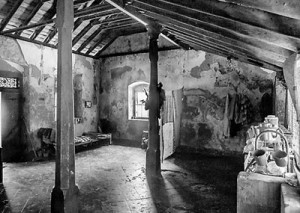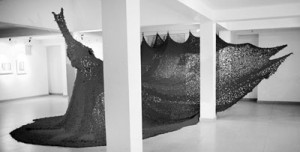Sunday Times 2
Sri Lankan Contemporary Art at Aicon Gallery, New York
View(s):
Dominic Sansoni Jaffna Homes III
Situated off the southern tip of South India, the lush Sri Lanka island has drawn visitors for centuries. But the carnage of the 26-year civil war, which ended in 2009, tore the country apart. During the most strident phase in the late 1990s artists began to denounce terror, and visual arts took a prominent place as a critical voice.
Many artists emerged as political individuals-some as rebels themselves loaded with an anti-establishment rhetoric. They became interventionists in their effort to expose the horrors and the aftermath of the civil war. Much like the voice of the subaltern, contemporary artists in Sri Lanka who felt marginalized and peripheral established their ideas and modes of expression from the consciousness of the outsider. In this way, their art became a radical language of resistance, with the intention of envisioning a space for uncertainty, deliberation, and thought. Many of the artists selected for this exhibition continue to foster this initiative and express their response to the lack of government support for war crime abuses, suppressed violence, inhuman treatment of refugees, women’s exploitation, and dislocation.
Portraits of Intervention is anchored by a series of works by the artist and theoretician Jagath Weerasinghe who coined the phrase “90s trend,” to describe a movement that exposed state sponsored terror, suppression, and insurgency. The collective effort by artists brought together by pain and common loss led to turbulent artistic modes often alluding to brutal violence and the tensions of urban dwelling. As a co-founder of the Theertha International Arts Collective in 2000, Weerasinghe was instrumental in shaping the raw expression of art through his own bold inelegant urban paintings of the fallen soldier-a mere pawn in the hands of the authorities– which captured the here and the now. In his recent sketchbooks, Weerasinghe depicts internal conflict and bodily degeneration from the consequences of the war with his trademark effusion of colour, energy, and emotion. In these organic drawings, microscopic particles of disease are enlarged and fear is magnified as the male body appears to be dissected with its organs exposed. Weerasinghe’s unmitigated endeavour to forge new methods of art practices that question and upend power provides a framework for the works on display to be understood.

Anoli Perera Second Skin: Elastic Dress II
Anoli Perera on the hand other, who was also a founder of Theertha, dwells on women’s issues and the daily entanglement of emotion in a patriarchal world. Her large flowing red dress made with woven elastic, and drawings shaped from old sewing artifacts consecrate the role and place of women still relegated to domestic chores. Issues of identity and freedom are formulated through the outline of the female figure in both her works.
Artists like Pradeep Chandrasiri and Bandu Manamperi, core members of Theertha, positioned their own bodies and lives at the pivot of their art making practices. Chandrasiri’s installation references his firsthand encounter with being interrogated, and the work serves as a memorial space for ongoing concealed violence. Images of Manamperi’s dynamic performances take the use of the body one step further in the way, for example, he conveys the force of violence by covering himself with Chinese fire crackers.
The body lurks beneath Priyantha Udagedara’s ostensibly decorative paintings. Alluding to sex workers from the war surreptitiously employed in spas, the artist reveals how their lives and traumas are completely concealed. Bodies and shapes dangle more ominously in Janananda Laksiri’s digital photographs that hint at the inherent insidiousness of political power. A similar kind of murky unease can be detected in Danushka Marasinghe’s manipulated found photographs, while Thisath Thoradeniya’s ironic charcoal drawings suggest human manipulation.
For Pala Pothupitiye, a permanent member of Theertha, maps are his métier. He uses old and new maps of Sri Lanka to reimagine colonial demarcations as much as he creates dialogues about insurgencies, isolation, and exclusion driven by greed and religious might. Similarly, archival images feature in Liz Fernando’s diasporic vision of a lost culture.
Loss and the ravages of war bleed through Dominic Sansoni’s deeply moving photographs of homes in the northern Tamil territory of Jaffna. Simple objects and furniture represent a sense of belonging that still remains inaccessible for many Tamils uprooted during the war from the region. This ordeal is expressed with ferocious honesty by the emerging Jaffna artists Savesan Nalliah’s and M. Vijitharan’s depiction of mayhem, chaos, and the brutal depredation of women in their hometown.
Yet despite the issue driven nature of the works, contemporary Sri Lankan art is evocative of larger emotions and a transcultural sensibility. Intervention here that plays on ambiguity and deracination is expressed through creativity and self-actualization. The discovery of meaning in their art becomes a process for self-discovery and transformation. It is this approach in which the notion of self and identity merge towards formulating a discussion that embraces the whole of humanity.
Bansie Vasvani is an art critic and writer with a focus on Asian and other non-Western art practices.
The Aicon Galery is at 35 Great Jones St., New York NY 10012
| Portraits of Intervention: Contemporary Art from Sri Lanka, a group exhibition curated by Bansie Vasvani, featuring works by Pradeep Chandrasiri, Liz Fernando, Janananda Laksiri, Bandu Manamperi, Danushka Marasinghe, Savesan Nallaiah, Anoli Perera, Pala Pothupitiye, Dominic Sansoni, Thisath Thoradeniya, Priyantha Udagedara, M. Vijitharan, and Jagath Weerasinghe will be open from April 1-19 at the Aicon Gallery in New York. |

